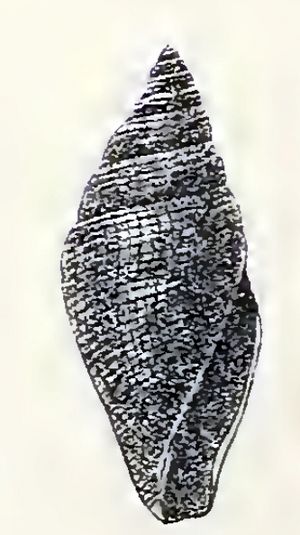Benthofascis atractoides facts for kids
Benthofascis atractoides was an ancient type of sea snail. It was a marine mollusk (a soft-bodied animal, often with a shell) that lived in the ocean long ago. This snail belonged to a group called gastropods, which includes all snails and slugs. It is now extinct, meaning it no longer lives on Earth. This species was part of the Conorbidae family of snails.
Quick facts for kids Benthofascis atractoides |
|
|---|---|
 |
|
| Original drawing of a shell of Benthofascis atractoides | |
| Scientific classification | |
| Synonyms | |
|
Conus (Conorbis) atractoides Tate, 1890 |
What it Looked Like
The shell of an adult Benthofascis atractoides was about 16.5 millimeters (a bit over half an inch) long. It was about 6.5 millimeters wide.
Its shell had a unique shape, often described as "biconic." This means it looked like two cones joined together at their widest parts. It was also "fusiform," which means it was spindle-shaped, wider in the middle and tapering at both ends.
The surface of the shell was smooth and shiny. It also had spiral grooves, like lines winding around it.
Shell Details
The top part of the shell, called the spire, was shaped like a regular cone. It made up about one-third of the shell's total length.
This spire had five main sections, called whorls. At the very tip was a small, blunt "protoconch." This was the first part of the shell that formed when the snail was a tiny larva. It had two and a half smooth, rounded whorls.
The main whorls of the shell were slightly curved outwards. They were separated by clear lines called "sutures." These whorls had six flat spiral ridges. The spaces between these ridges sometimes had tiny dots.
The largest part of the shell is called the body whorl. This section was slightly angled at its widest point. It had about 30 flat spiral ridges. These ridges were separated by narrow grooves. The shell also showed faint growth lines, which looked like small marks in the grooves.
The opening of the shell, called the aperture, was narrow. It was wide at the front and measured about half the length of the entire shell. The outer edge of this opening, called the outer lip, was thin and sharp. It had a smooth inside and was curved in the middle.
Where it Lived
Benthofascis atractoides was an extinct marine species. This means it lived in the ocean and is no longer found alive today.
It was "endemic" to Australia. This means it was only found in Australia and nowhere else in the world. This species lived during a time called the Lower Miocene epoch. This was a long time ago, roughly between 23 and 16 million years ago.

